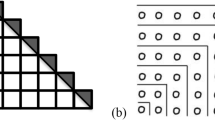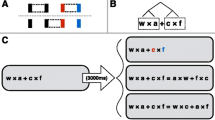Abstract
The view that imagery might be a disadvantage on certain tasks might surprise some mathematics educators who contend that a learner's conceptual understanding is increased whenever visual imagery is used. One of the limitations of imagery found in the literature comes to bear on a unique aspect of mathematics teaching and learning. This is the notion of an uncontrollable image, which may persist, thereby preventing the opening up of more fruitful avenues of thought, a difficulty which is particularly acute if the image is vivid. Although one calculus student's images supported high levels of mathematical functioning, occasionally his vivid images became uncontrollable, and the power of these images did more to obscure than to explain. This type of imagery can be a major hindrance in constructing meaning for mathematical concepts — contrary to the ‘panacea’ view of imagery which is sometimes expressed.
Similar content being viewed by others
REFERENCES
Aspinwall, L.: 1994, The role of graphic representations and students' images in understanding the derivative in calculus: Critical case studies. Unpublished doctoral dissertation, Florida State University, Tallahassee, Florida.
Aspinwall, L., Shaw, K. and Presmeg, N.: 1995, Uncontrollable images: Graphical connections between a function and its derivative. Paper presented to the Joint Mathematics Meetings of the 78th Annual Meeting of the Mathematical Association of America and the 101st Annual Meeting of the American Mathematics Society, San Francisco, California, January.
Bartlett, F.C.: 1977, Remembering: A Study in Experimental and Social Psychology, Cambridge University Press, Cambridge.
Casey, E.S.: 1976, Imagining: A Phenomenological Study, Indiana University Press, Bloomington.
Clement, J. and Kaput, J.J.: 1979, Lett to the editor. The Journal of Children Mathematical Behavior 2(2), 208.
Clements, M.A.: 1981, ‘Visual imagery and school mathematics’, Part 1. For the Learning of Mathematics 2(2), 2–9.
Douglas, R.G. (ed.): 1986, Toward a Lean and Lively Calculus (MAA Notes 6), Mathematical Association of America, Washington, DC.
Eisenberg, T. and Dreyfus, T.: 1991, ‘On the reluctance to visualize in mathematics’, in W. Zimmermann and S. Cunningham (eds), Visualization in Teaching and Learning Mathematics, Mathematical Association of America, Washington, DC, pp. 25–37.
Guba, E. and Lincoln, Y.: 1981, Effective Evaluation: Improving the Usefulness of Evaluation Results Through Responsive and Naturalistic Methods, Jossey-Bass, San Francisco.
Hallet, D.H.: 1991, ‘Visualization and calculus reform’, in W. Zimmermann and S. Cunningham (eds.), Visualization in Teaching and Learning Mathematics, Mathematical Association of America, Washington, DC, pp. 121–126.
Janvier, C.: 1987a, ‘Conception and representations: The circle as an example’, in C. Janvier (ed.), Problems of Representation in the Teaching and Learning of Mathematics, Lawrence Erlbaum Associates, Hillsdale, NJ, pp. 147–1581.
Janvier, C.: 1987b, ‘Representation and understanding: The notion of function as an example’, in C. Janvier (ed.), Problems of Representation in the Teaching and Learning of Mathematics, Lawrence Erlbaum Associates, Hillsdale, NJ, pp. 67–71.
Kosslyn, S.M.: 1980, Image and Mind, Harvard University Press, Cambridge, MA.
Krutetskii, V.A.: 1969, in J. Kilpatrick and I. Wirszup (eds.), Soviet Studies in the Psychology of Learning and Teaching Mathematics. Vol. II: The Structure of Mathematical Abilities, University of Chicago Press, Chicago.
Krutetskii, V.A.: 1976, The Psychology of Mathematical Abilities in Schoolchildren, University of Chicago Press, Chicago.
Lakoff, G.: 1987, Women Fire, and Dangerous Things: What Categories Reveal About the Mind, The University of Chicago Press, Chicago.
Lean, G. and Clements, K.: 1981, ‘Spatial ability, visual imagery, and mathematical performance’, Educational Studies in Mathematics 12, 267–299.
Lesh, R., Behr, M. and Post, T.: 1987, ‘Rational number relations and proportions’, in C. Janvier (ed.), Problems of Representation in the Teaching and Learning of Mathematics, Lawrence Erlbaum Associates, Hillsdale, NJ, pp. 41–58.
Lincoln, Y. and Guba, E.: 1985, Naturalistic Inquiry, Sage Publications, Newbury Park, CA.
MacFarlane Smith, I.M.: 1964, Spatial Ability, its Educational and Social Significance, University of London Press, London.
Mandler, J.M.: 1976, ‘Some problems in the definition and measurement of imagery’, Child Development 47, 888–889.
Merriam, S.: 1985, ‘The case study in educational research: A review of selected literature’, The Journal of Educational Thought 19, 204–217.
National Council of Teachers of Mathematics: 1989, Curriculum and Evaluation Standards for School Mathematics, Reston, VA.
Presmeg, N.C.: 1985, The Role of Visually Mediated Processes in High School Mathematics: A Classroom Investigation, Unpublished Ph.D. dissertation, University of Cambridge.
Presmeg, N.C.: 1986, ‘Visualisation in high school mathematics’, For the Learning of Mathematics 6(3), 42–48.
Presmeg, N.C.: 1992, ‘Prototypes, metaphors, metonymies and imaginative rationality in high school mathematics’, Educational Studies in Mathematics 23, 595–610.
Radatz, H.: 1979, ‘Error analysis in mathematics education’, Journal for Research in Mathematics Education 10(3).
Richardson, A.: 1969, Mental Imagery, Routledge and Kegan Paul, London.
Selden, J., Mason, A. and Selden, A.: 1989, ‘Can average calculus students solve nonroutine problems’, Journal of Mathematical Bahvior 8, 45–50.
Sims-Knight, J. and Kaput, J.: 1983, ‘Misconceptions of algebraic symbols: Representations and component processes’, in J. Novak (ed.), Proceedings of the International Seminar on Misconceptions in Mathematics and Science, ERIC Clearinghouse for Science, Mathematics, and Environmental Education, Columbus, OH, pp. 477–488.
Steen, L.A. (ed.): 1989, Reshaping College Mathematics (MAA Notes 13), Mathematical Association of America, Washington, DC.
Steffe, L.: 1991, The constructivist teaching experiment: Illustrations and implications’, in E. von Glasersfeld (ed.), Radical Constructivism in Mathematics Education, Kluwer Academic Publishers, London, pp. 177–194.
Tall, D.: 1991, ‘Intuition and rigor: The role of visualization in the calculus’, in W. Zimmermann and S. Cunningham (eds.), Visualization in Teaching and Learning Mathematics, Mathematical Association of America, Washington, DC, pp. 105–119.
Tucker, T. (ed.): 1988, Priming the Calculus Pump: Innovations and Resources (MAA Notes 17), Mathematical Association of America, Washington, DC.
Tall, D. and Vinner, S.: 1981, ‘Concept image and concept definition in mathematics with particular reference to limits and continuity’, Educational Studies in Mathematics 12, 151–169.
Vinner, S.: 1989, ‘The avoidance of visual considerations in calculus students’, Focus on Learning Problems in Mathematics 11(2), 149–156.
Wheatley, G.H.: 1991, ‘Enhancing mathematics learning through imagery’, Arithmetic Teacher 39(1), 34–36.
Wheatley, G.H. and Brown, D.: 1994, The construction and representation of images in mathematical activity: Image as metaphor. Paper presented at the 18th Annual Meeting of the International Group for the Psychology of Mathematics Education, Lisbon, July–August.
Wheatley, G. and Cobb, P.: 1990, ‘Analysis of young children's spatial constructions’, in L. Steffe and T. Wood (eds.), Transforming Children's Mathematics Education: An International Perspective, Lawrence Erlbaum Press, Hillsdale.
Zimmermann, W.: 1991, ‘Visual thinking in calculus’, in W. Zimmermann and S. Cunningham (eds.), Visualization in Teaching and Learning Mathematics, Mathematical Association of America, Washington, DC, pp. 127–137.
Zimmermann, W. and Cunningham, S.: 1991, ‘Editors' introduction: What is mathematical visualization’, in W. Zimmermann and S. Cunningham (eds.), Visualization in Teaching and Learning Mathematics, Mathematical Association of America, Washington, DC, pp. 1–7.
Author information
Authors and Affiliations
Rights and permissions
About this article
Cite this article
Aspinwall, L., Shaw, K.L. & Presmeg, N.C. Uncontrollable Mental Imagery: Graphical Connections Between A Function And Its Derivative. Educational Studies in Mathematics 33, 301–317 (1997). https://doi.org/10.1023/A:1002976729261
Issue Date:
DOI: https://doi.org/10.1023/A:1002976729261




